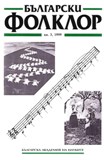Ситната игра – от сакрална към стилова характеристика
Sitnata Igra – from Sacral to Stylization
Author(s): Anna ShtarbanovaSubject(s): Anthropology
Published by: Институт за етнология и фолклористика с Етнографски музей при БАН
Summary/Abstract: The article is an attempt to experiment with yet another and very unusual point of view to the style of folk dancing. It focuses itself on a single dance and characterizes its structure, movements and presentation, but also its semantic aspects. The links between the ritual and the nonritual dances are obvious and could easily be discovered on structural level within the dances coming from a particular region. Thus there would naturally follow a question in regards to the nature of the mentioned above links and especially if they are or they are not resulting from the use of a common dancing motif stock or are also the result of some semantic interrelations. Until recently traditional Bulgarian music and dancing styles were predominantly investigated on the level of their regional variants reporting differences in outlook. An attempt has been undertaken here to gain an inward oriented description of the processes of regional style creation, as well as to explain it as reliant on the basic mechanisms of interdependence between ritual and dance. Thus, a special model of style investigation is offered. It allows for the adequate description and analysis of sitnata po stareshki, a dance which is to be considered not only the most widely spread one in Northeastern Bulgaria, but which is advocated to be representative for the whole of the region under consideration. Following the semantics of staro (old) and sitno (tiny, fine, elaborate), there are offered the following conclusions: I) Basic style characteristics are formed due to emancipation of the elements from their ritual contexts and meanings. Due to overpassing the boundaries of their ritual predetermination and meanings, the elements turned to be a stylistic mark, rather than being directly connected to their original content in the ritual context of the classical traditional culture. Thus, they are no longer sacred. 2) Nevertheless, their new standing is still deeply rooted in their former sacral meanings and function and. Thus, it is especially the latter which predetermines their high, ideal status in the new aesthetic conception, taking into consideration their old ritual importance and significance.
Journal: Български фолклор
- Issue Year: XXV/1999
- Issue No: 3
- Page Range: 16-20
- Page Count: 5
- Language: Bulgarian
- Content File-PDF

